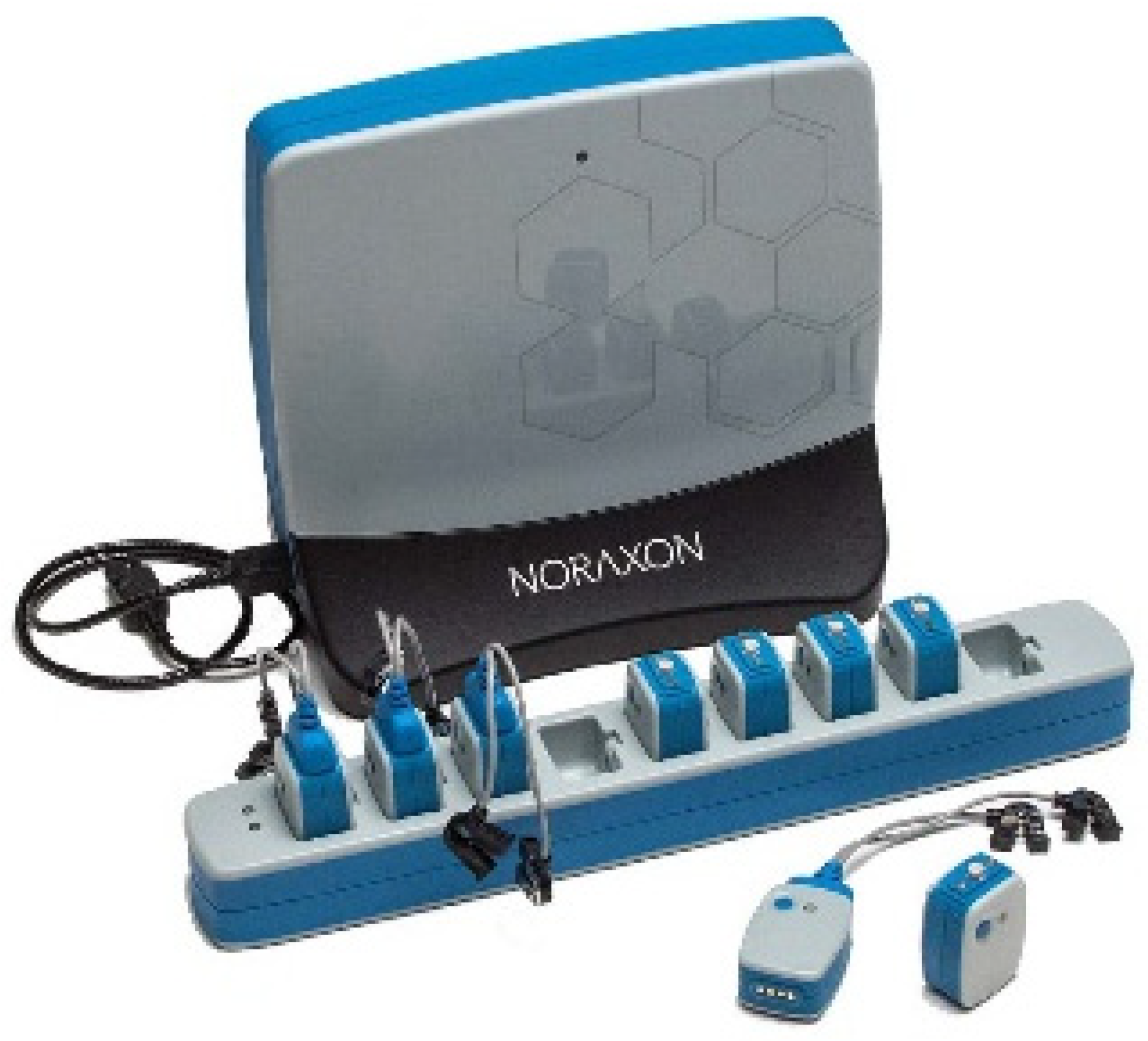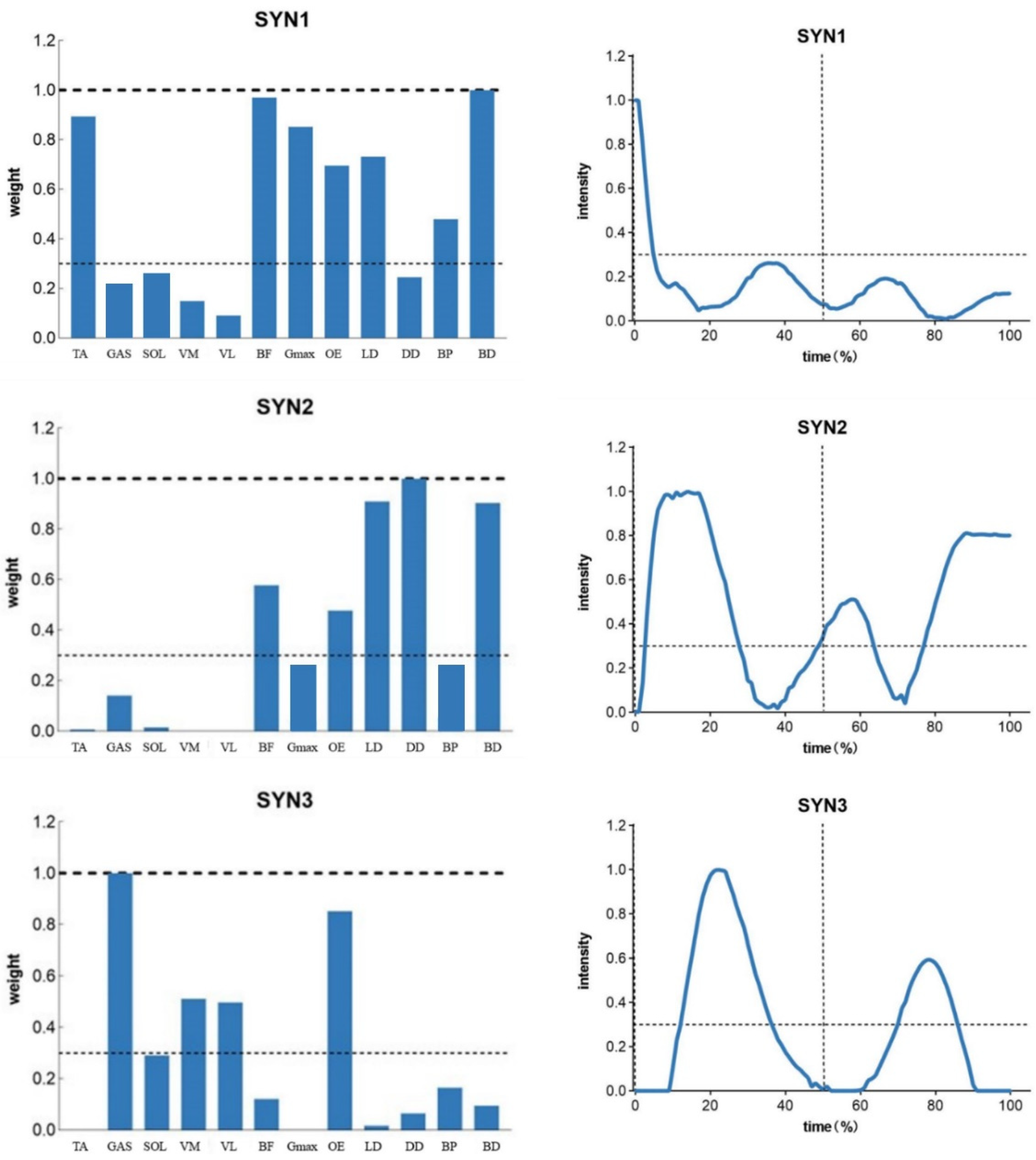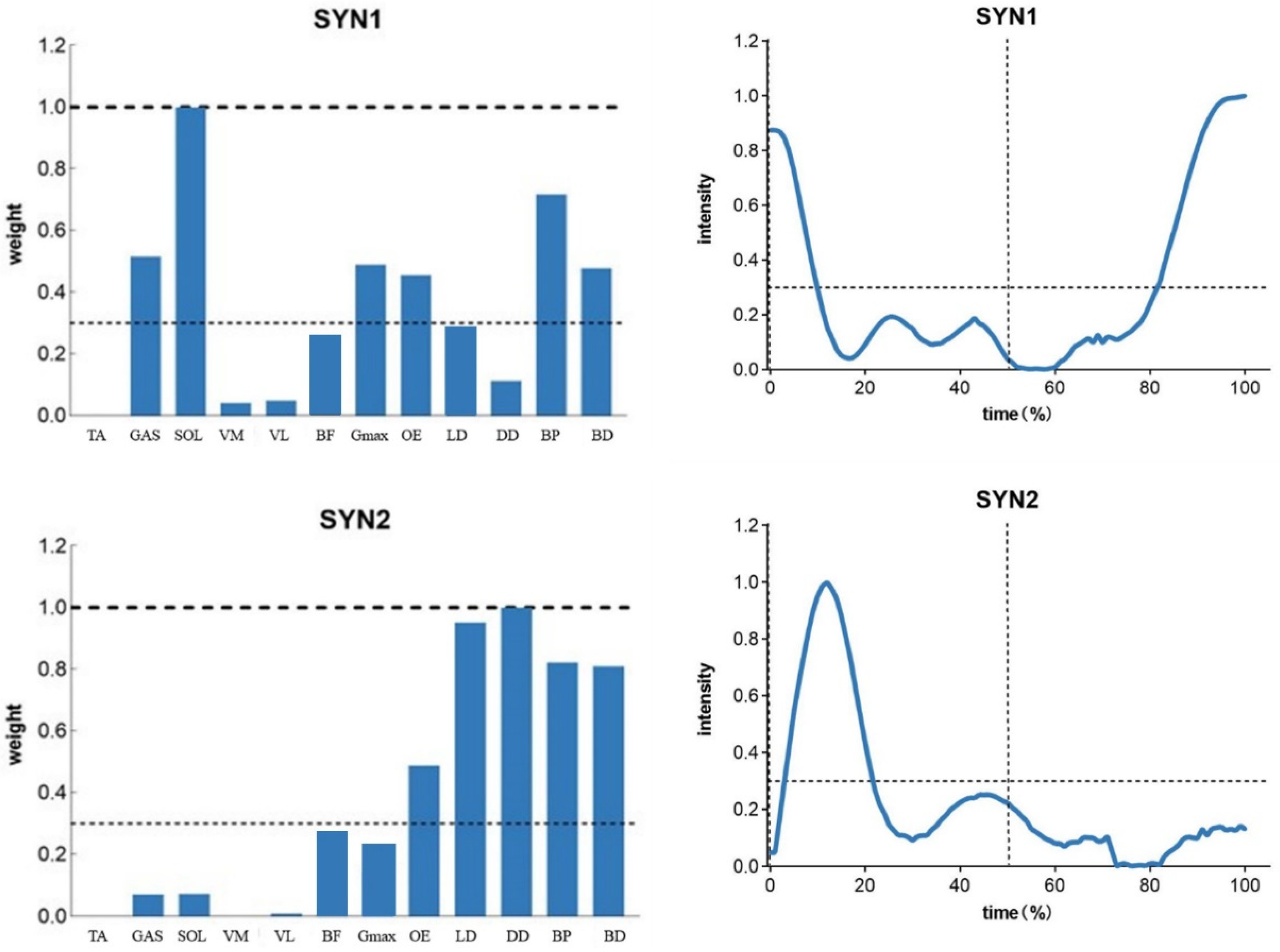Characterization of Muscle Activation and Muscle Synergism in the ‘Forward Lunge’ Gait Movement of Badminton Players Using Surface Electromyography Sensors
Abstract
1. Introduction
2. Participants and Methods
2.1. Participants
2.2. Data Acquisition
2.3. Division of the ‘Forward Lunge’ Step Cycle
2.4. EMG Data Processing
2.5. Extraction of Muscle Synergies
2.6. Statistical Analyses
3. Results
3.1. iEMG and RMS Results
3.2. Muscle Synergy Results
4. Discussion
5. Conclusions
Author Contributions
Funding
Institutional Review Board Statement
Informed Consent Statement
Data Availability Statement
Conflicts of Interest
References
- Ochsmann, E.; Koinzer, C. Analgesic drug use of recreational and competitive badminton players: Starting points for prevention. Transl. Sports Med. 2021, 4, 458–469. [Google Scholar] [CrossRef]
- Hu, X.; Jiang, Q. A study on the assessment and scoring standard of badminton course in colleges and universities: A review. Medicine 2022, 101, e32230. [Google Scholar] [CrossRef]
- Lin, K.-C.; Ko, C.-W.; Hung, H.-C.; Chen, N.-S. The effect of real-time pose recognition on badminton learning performance. Interact. Learn. Environ. 2023, 31, 4772–4786. [Google Scholar] [CrossRef]
- Liang, Z.; Yin, D.; Liu, T.; Lin, H.; Jin, H. High perceptual sensitivity to global motion in badminton players. Int. J. Sport Psychol. 2021, 52, 90–100. [Google Scholar] [CrossRef]
- Putra, V.G.V.; Irwan; Mohamad, J.N. A novel mathematical model of the badminton smash: Simulation and modeling in biomechanics. Comput. Methods Biomech. Biomed. Eng. 2024, 27, 538–545. [Google Scholar] [CrossRef] [PubMed]
- Pratama, A.P.; Sukamti, E.R.; Suhartini, B.; Sulistiyowati, E.M.; Ilham, I.; Ayubi, N. Effects of Shadow Training and Leg Muscle Strength on Badminton Footwork Agility: A Factorial Experimental Design. Retos Nuevas Perspect. Educ. Física Deporte Recreación 2024, 54, 207–215. [Google Scholar] [CrossRef]
- Guermont, H.; Le Van, P.; Marcelli, C.; Reboursière, E.; Drigny, J. Epidemiology of Injuries in Elite Badminton Players: A Prospective Study. Clin. J. Sport Med. 2021, 31, e473–e475. [Google Scholar] [CrossRef] [PubMed]
- Mohd Jamali MN, Z.; Selvanayagam, V.S.; AHamid, M.S.; Yusof, A. Prevalence, patterns and factors associated with injury: Comparison between elite Malaysian able-bodied and para-badminton players. Physician Sportsmed. 2022, 50, 316–322. [Google Scholar] [CrossRef]
- Marchena-Rodriguez, A.; Cabello-Manrique, D.; Ortega-Avila, A.B.; Martinez-Rico, M.; Cervera-Garvi, P.; Gijon-Nogueron, G. Aetiology, epidemiology and treatment of musculoskeletal injuries in badminton players: A systematic review and meta-analysis. Res. Sports Med. 2024, 32, 1041–1054. [Google Scholar] [CrossRef]
- Hu, Z.; Zhang, Y.; Dong, T.; Dong, M.; Kim, S.; Kim, Y. Gender Differences in Neuromuscular Control during the Preparation Phase of Single-Leg Landing Task in Badminton. J. Clin. Med. 2023, 12, 3296. [Google Scholar] [CrossRef]
- Wang, Y.; Xu, L.; Jiang, H.; Yu, L.; Wu, H.; Mei, Q. Biomechanical Effects of the Badminton Split-Step on Forecourt Lunging Footwork. Bioengineering 2024, 11, 501. [Google Scholar] [CrossRef] [PubMed]
- Saragaglia, D.; Banihachemi, J.J.; Chamseddine, A.H. Acute injuries in Badminton from 10 to 66 years of age: An epidemiological study of 140 cases among all types of practice. Eur. J. Orthop. Surg. Traumatol. 2023, 33, 1945–1951. [Google Scholar] [CrossRef]
- Hides, J.A.; Dilani Mendis, M.; Leung, F.; Grantham, B.; Coombes, B. Exploring the relationship between trunk muscles and lower limb injuries in Australian badminton players. J. Biomech. 2024, 176, 112325. [Google Scholar] [CrossRef]
- Lim, J.; Lu, L.; Goonewardena, K.; Liu, J.Z.; Tan, Y. Assessment of Self-report, Palpation, and Surface Electromyography Dataset During Isometric Muscle Contraction. Sci. Data 2024, 11, 208. [Google Scholar] [CrossRef] [PubMed]
- Pashaei, M.; Babakhani, F.; Banihashemi, K. Evaluation of surface electromyography of selected neck muscles during the whiplash mechanism in aware and unaware conditions due to safe punching in kickboxing. BMC Musculoskelet. Disord. 2023, 24, 429. [Google Scholar] [CrossRef] [PubMed]
- Abutalimova, S.M. Bioelectrical Activity of Muscles in Trained Weightlifters During the Snatch. Hum. Sport Med. 2022, 22, 84–91. [Google Scholar] [CrossRef]
- Markström, J.L.; Grinberg, Y.; Sole, G.; Häger, C.K. Strategies for knee stabilising and pivot-shift avoidance in a step-down and cross-over task observed sub-acutely after anterior cruciate ligament reconstruction. Clin. Biomech. 2024, 115, 106255. [Google Scholar] [CrossRef]
- Khera, P.; Das, T.; Kakoty, N.M.; Kumar, N. AI-enabled Hybrid Model for Lower-Limb Movements Recognition using Estimated Muscular Activity from Cortical Brain Signals. IETE J. Res. 2024, 70, 5270–5279. [Google Scholar] [CrossRef]
- Lin, X.; Hu, Y.; Sheng, Y. The Effect of Electrical Stimulation Strength Training on Lower Limb Muscle Activation Characteristics During the Jump Smash Performance in Badminton Based on the EMS and EMG Sensors. Sensors 2025, 25, 577. [Google Scholar] [CrossRef]
- Cheng, K.-C.; Chiu, Y.-L.; Tsai, C.-L.; Hsu, Y.-L.; Tsai, Y.-J. Fatigue Affects Body Acceleration During Vertical Jumping and Agility Tasks in Elite Young Badminton Players. Sports Health 2025, 17, 126–134. [Google Scholar] [CrossRef]
- Abián-Vicén, J. Effect of balance training on footwork performance in badminton: An interventional study. PLoS ONE 2022, 17, e0277775. [Google Scholar] [CrossRef]
- Kim, S.-O.; Choi, N.-Y.; Yoo, N.-Y.; Park, S.-A. Upper and Lower Limb Muscle Activation during Green Care: An Electromyographic Analysis. HortScience 2024, 59, 934–940. [Google Scholar] [CrossRef]
- Bouchard-Tremblay, J.; Théberge, M.; Ayoub, T.; Martel-Brosseau, G.; Levasseur-Ouellet, M.-P.; Tremblay, M.; Houde-Thibeault, A.; Wotto, E.A.; Carezolli, F.R.; Hébert, L.J.; et al. Age- and Parkinson-related differences in trunk and lower-limb muscle activation during four balance tasks: A case-control pilot study. Clin. Biomech. 2024, 117, 106298. [Google Scholar] [CrossRef] [PubMed]
- Waldon, K.T.; Stout, A.; Manning, K.; Gray, L.; Wilson, D.G.; Kang, G.E. Dual-Task Interference Effects on Lower-Extremity Muscle Activities during Gait Initiation and Steady-State Gait among Healthy Young Individuals, Measured Using Wireless Electromyography Sensors. Sensors 2023, 23, 8842. [Google Scholar] [CrossRef]
- Hajiloo, B.; Anbarian, M.; Esmaeili, H.; Mirzapour, M. The effects of fatigue on synergy of selected lower limb muscles during running. J. Biomech. 2020, 103, 109692. [Google Scholar] [CrossRef]
- Pan, Z.; Liu, L.; Li, X.; Ma, Y. An analysis of the effect of motor experience on muscle synergy in the badminton jump smash. Hum. Mov. Sci. 2024, 95, 103209. [Google Scholar] [CrossRef] [PubMed]
- Rabbi, M.F.; Pizzolato, C.; Lloyd, D.G.; Carty, C.P.; Devaprakash, D.; Diamond, L.E. Non-negative matrix factorisation is the most appropriate method for extraction of muscle synergies in walking and running. Sci. Rep. 2020, 10, 8266. [Google Scholar] [CrossRef]
- Ao, D.; Shourijeh, M.S.; Patten, C.; Fregly, B.J. Evaluation of Synergy Extrapolation for Predicting Unmeasured Muscle Excitations from Measured Muscle Synergies. Front. Comput. Neurosci. 2020, 14, 588943. [Google Scholar] [CrossRef]
- Kim, H.; Lee, J.; Kim, J. Muscle Synergy Analysis for Stroke During Two Degrees of Freedom Reaching Task on Horizontal Plane. Int. J. Precis. Eng. Manuf. 2020, 21, 319–328. [Google Scholar] [CrossRef]
- Taniguchi, M.; Umehara, J.; Yamagata, M.; Yagi, M.; Motomura, Y.; Okada, S.; Okada, S.; Nakazato, K.; Fukumoto, Y.; Kobayashi, M.; et al. Understanding muscle coordination during gait based on muscle synergy and its association with symptoms in patients with knee osteoarthritis. Clin. Rheumatol. 2024, 43, 743–752. [Google Scholar] [CrossRef]
- Matsunaga, N.; Okubo, Y.; Isagawa, S.; Niitsuma, J.; Otsudo, T.; Sawada, Y.; Akasaka, K. Muscle fatigue in the gluteus maximus changes muscle synergies during single-leg landing. J. Bodyw. Mov. Ther. 2021, 27, 493–499. [Google Scholar] [CrossRef]
- Barnamehei, H.; Tabatabai Ghomsheh, F.; Safar Cherati, A.; Pouladian, M. Upper Limb Neuromuscular Activities and Synergies Comparison between Elite and Nonelite Athletics in Badminton Overhead Forehand Smash. Appl. Bionics Biomech. 2018, 2018, 6067807. [Google Scholar] [CrossRef] [PubMed]
- Fu, L.; Ren, F.; Baker, J.S. Comparison of Joint Loading in Badminton Lunging between Professional and Amateur Badminton Players. Appl. Bionics Biomech. 2017, 2017, 5397656. [Google Scholar] [CrossRef]
- Lam, W.K.; Wong, D.W.; Lee, W.C. Biomechanics of lower limb in badminton lunge: A systematic scoping review. PeerJ 2020, 8, e10300. [Google Scholar] [CrossRef] [PubMed]
- Ma, S.; Soh, K.G.; Japar, S.B.; Liu, C.; Luo, S.; Mai, Y.; Wang, X.; Zhai, M. Effect of core strength training on the badminton player’s performance: A systematic review & meta-analysis. PLoS ONE 2024, 19, e0305116. [Google Scholar] [CrossRef]
- Pardiwala, D.N.; Subbiah, K.; Rao, N.; Modi, R. Badminton Injuries in Elite Athletes: A Review of Epidemiology and Biomechanics. Indian J. Orthop. 2020, 54, 237–245. [Google Scholar] [CrossRef] [PubMed]
- Zemková, E.; Zapletalová, L. The Role of Neuromuscular Control of Postural and Core Stability in Functional Movement and Athlete Performance. Front. Physiol. 2022, 13, 796097. [Google Scholar] [CrossRef]
- Liu, X.; Imai, K.; Zhou, X.; Watanabe, E. Influence of Ankle Injury on Subsequent Ankle, Knee, and Shoulder Injuries in Competitive Badminton Players Younger Than 13 Years. Orthop. J. Sports Med. 2022, 10, 23259671221097438. [Google Scholar] [CrossRef]
- Fort-Vanmeerhaeghe, A.; Romero-Rodriguez, D.; Lloyd, R.S.; Kushner, A.M.; Myer, G.D. Integrative Neuromuscular Training in Youth Athletes. Part II: Strategies to Prevent Injuries and Improve Performance. Strength Cond. J. 2016, 38, 9–27. [Google Scholar] [CrossRef]




| Indicator | Professional Group | Amateur Group | p-Value | FDR-Adjusted p-Value |
|---|---|---|---|---|
| Age (year) | 25.3 ± 3.2 | 24.8 ± 2.7 | 0.678 | 0.678 |
| Height (cm) | 177.5 ± 5.4 | 176.3 ± 4.8 | 0.523 | 0.704 |
| Weight (kg) | 73.2 ± 7.4 | 71.8 ± 6.9 | 0.564 | 0.704 |
| BMI (kg/m2) | 23.2 ± 2.1 | 22.9 ± 2.3 | 0.704 | 0.812 |
| Muscle | Professional Group | Amateur Group | p-Value | FDR-Adjusted p-Value |
|---|---|---|---|---|
| TA | 0.384 ± 0.127 | 0.441 ± 0.129 | 0.642 | 0.963 |
| GAS | 0.290 ± 0.079 | 0.167 ± 0.014 | 0.004 | 0.024 |
| VM | 0.230 ± 0.030 | 0.262 ± 0.042 | 0.290 | 0.580 |
| VL | 0.606 ± 0.020 | 0.548 ± 0.141 | 0.399 | 0.684 |
| BF | 0.213 ± 0.041 | 0.150 ± 0.016 | 0.028 | 0.048 |
| Gmax | 0.273 ± 0.064 | 0.197 ± 0.050 | 0.029 | 0.047 |
| OE | 0.864 ± 0.043 | 0.830 ± 0.022 | 0.016 | 0.036 |
| LD | 0.347 ± 0.038 | 0.253 ± 0.048 | 0.007 | 0.008 |
| SOL | 0.686 ± 0.251 | 0.732 ± 0.231 | 0.732 | 0.976 |
| DD | 0.437 ± 0.063 | 0.443 ± 0.055 | 0.844 | 0.731 |
| BP | 0.483 ± 0.082 | 0.482 ± 0.195 | 0.973 | 0.973 |
| BD | 0.789 ± 0.059 | 0.791 ± 0.053 | 0.884 | 0.864 |
| Muscle | Professional Group | Amateur Group | p-Value | FDR-Adjusted p-Value |
|---|---|---|---|---|
| TA | 0.459 ± 0.075 | 0.495 ± 0.091 | 0.237 | 0.406 |
| GAS | 0.402 ± 0.066 | 0.312 ± 0.021 | 0.002 | 0.012 |
| VM | 0.392 ± 0.027 | 0.308 ± 0.035 | 0.004 | 0.012 |
| VL | 0.626 ± 0.011 | 0.595 ± 0.121 | 0.384 | 0.517 |
| BF | 0.296 ± 0.041 | 0.276 ± 0.012 | 0.118 | 0.236 |
| Gmax | 0.345 ± 0.042 | 0.267 ± 0.022 | 0.003 | 0.012 |
| OE | 0.869 ± 0.041 | 0.839 ± 0.021 | 0.007 | 0.017 |
| LD | 0.413 ± 0.039 | 0.370 ± 0.032 | 0.004 | 0.012 |
| SOL | 0.704 ± 0.135 | 0.761 ± 0.102 | 0.388 | 0.517 |
| DD | 0.507 ± 0.066 | 0.503 ± 0.046 | 0.851 | 0.851 |
| BP | 0.517 ± 0.061 | 0.526 ± 0.064 | 0.755 | 0.824 |
| BD | 0.701 ± 0.050 | 0.691 ± 0.064 | 0.722 | 0.824 |
Disclaimer/Publisher’s Note: The statements, opinions and data contained in all publications are solely those of the individual author(s) and contributor(s) and not of MDPI and/or the editor(s). MDPI and/or the editor(s) disclaim responsibility for any injury to people or property resulting from any ideas, methods, instructions or products referred to in the content. |
© 2025 by the authors. Licensee MDPI, Basel, Switzerland. This article is an open access article distributed under the terms and conditions of the Creative Commons Attribution (CC BY) license (https://creativecommons.org/licenses/by/4.0/).
Share and Cite
Jiang, J.; Li, H.; Xiu, C. Characterization of Muscle Activation and Muscle Synergism in the ‘Forward Lunge’ Gait Movement of Badminton Players Using Surface Electromyography Sensors. Sensors 2025, 25, 1644. https://doi.org/10.3390/s25061644
Jiang J, Li H, Xiu C. Characterization of Muscle Activation and Muscle Synergism in the ‘Forward Lunge’ Gait Movement of Badminton Players Using Surface Electromyography Sensors. Sensors. 2025; 25(6):1644. https://doi.org/10.3390/s25061644
Chicago/Turabian StyleJiang, Jian, Haojie Li, and Chen Xiu. 2025. "Characterization of Muscle Activation and Muscle Synergism in the ‘Forward Lunge’ Gait Movement of Badminton Players Using Surface Electromyography Sensors" Sensors 25, no. 6: 1644. https://doi.org/10.3390/s25061644
APA StyleJiang, J., Li, H., & Xiu, C. (2025). Characterization of Muscle Activation and Muscle Synergism in the ‘Forward Lunge’ Gait Movement of Badminton Players Using Surface Electromyography Sensors. Sensors, 25(6), 1644. https://doi.org/10.3390/s25061644






